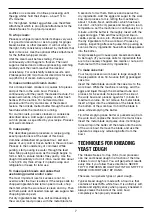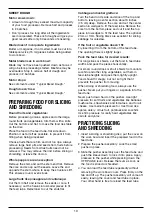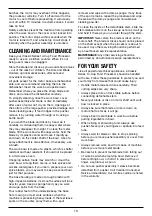
9
Making consecutive batches:
You can make several batches of bread dough
in a row. The motor in the Classic Series 14-Cup
Food Processor is extremely efficient. Follow the
recipe for White Bread, page 26 of the Recipe
Booklet.
PROBLEMS & SOLUTIONS
WITH TYPICAL DOUGH
BREAD DOUGH
Blade doesn’t incorporate ingredients:
Always start processor before adding liquids. Add
liquid in slow, steady stream, only as fast as dry
ingredients absorb it. If you hear liquid sloshing, stop
adding it, but do not turn off machine. Instead, wait
until ingredients in work bowl have mixed, then add
remaining liquid slowly. Pour liquid onto dough as it
passes under feed tube; do not pour liquid directly
onto bottom of work bowl.
Blade rises in work bowl:
Blade may not have been pushed down as far as it
will go before processing started.
Excessively sticky dough can cause blade to rise
even though it cleans inside of work bowl. If dough
feels very sticky, carefully reinsert blade and
immediately add 2 tablespoons (30 ml) flour through
feed tube while machine is running.
Dough doesn’t clean inside of work bowl:
• Amount of dough may exceed maximum capacity
of your food processor. Remove half and process
in 2 batches.
• Dough may be too dry. If it feels crumbly, add
water – 1 tablespoon (15 ml) at a time – while
machine is running, until dough becomes moist
and cleans inside of work bowl. Wait 10 seconds
between additions of water.
• Dough may be too wet. While machine is running,
add 1 tablespoon (15 ml) of flour. If necessary, add
more – 1 tablespoon (15 ml) at a time – until dough
cleans inside of work bowl and forms a ball.
Nub of dough forms on top of blade and does
not become uniformly kneaded:
Stop machine, carefully remove dough, divide it into
3 pieces and redistribute them evenly in work bowl.
Continue processing until dough is uniformly soft
and pliable.
Dough feels tough after kneading:
Divide dough into 2 or 3 pieces and redistribute
evenly in bowl. Process 10 seconds or until
uniformly soft and pliable.
Soft dough or liquid leaks onto base of food
processor:
Always start processor before adding liquid and add
liquid only as fast as dry ingredients absorb it.
Motor stops:
• Pusher assembly may have become unlocked.
Push down pusher sleeve to lock it into place and
continue processing.
• Power cord may have become unplugged. Plug
machine in and continue processing.
• Excessive strain may have caused motor to
overheat and stop. Wait for the motor to cool off,
5–10 minutes. A safety protector in the motor
prevents it from excessive overheating. If the
motor stops, turn the machine off. After 5–
10 minutes, divide dough into 2 batches and
complete processing. Pinch dough to make sure
that it is not too stiff to knead comfortably by
hand. If it is, add liquid – 1 teaspoon (5 ml) at a
time – until dough is sufficiently moist to clean
inside of bowl.
Dough doesn’t rise:
We recommend that you always test activity of yeast
before using it by stirring it and at least
½
teaspoon
(2.5 ml) sugar into about
1
⁄
3
cup (75 ml) warm
liquid (105°F–115°F [40°C-46°C]). Within 10 minutes
foam should develop, indicating yeast is active. Do
not use dry yeast after expiration date on package.
Avoid killing yeast cells by dissolving yeast in too
warm water or overheating dough by excessive
kneading. Dissolve yeast in about
1
⁄
3
cup (75 ml) of
warm liquid at 105°-115°F (40°-46°C). All other liquid
should be cold.
Don’t knead so long that it becomes overheated.
The ideal temperature for kneaded dough is 80°F
(27°C); it should never exceed 100°F (38°C).
Let dough rise in draft-free environment of about
80°–90°F (27°C-32°C).
Dough containing whole grain flour will take longer
to rise than dough made of white flour only.
Baked bread is too heavy:
Next time, feel dough to be sure it is uniformly soft,
pliable and slightly sticky before setting it aside to
rise. Let dough fully double in bulk in bowl or bag,
punch it down, then let it double again after it is
shaped.

































